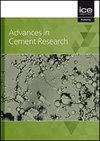Analysis of the evolution of internal corrosion cracks in RMOCC compared with GLCM and SVM
IF 1.3
4区 工程技术
Q3 CONSTRUCTION & BUILDING TECHNOLOGY
引用次数: 0
Abstract
In view of the difficulty of identifying internal micro corrosion-induced cracks in concrete and the poor accuracy of quantitative analysis that results in inaccurate results of the formation law of internal cracks, RMOCC was subjected to a galvanostatic acceleration test, and X-CT technology was combined with the Support Vector Machines (SVM) identification algorithm and Grey-Level Co-Occurrence Matrix (GLCM) theory. Using the SVM algorithm and GLCM theory, the internal average crack width of concrete and the contrast, correlation, angular second moment (ASM), and inverse difference moment (IDM), which characterize the change in slice texture information, were used as degradation parameters, respectively. Using the average internal crack width and IDM as the degradation index, a reliability degradation competition failure analysis was conducted to study RMOCC's internal crack formation law. The results showed that the SVM algorithm had a greater than 95% accuracy in recognizing cracks. In the entire corrosion-induced crack formation process, IDM and the average internal crack width values were consistent with the normal distribution. Through reliability degradation competition failure analysis between IDM and the average crack width value, the average crack width calculated with SVM is more suitable for the degradation analysis of internal corrosion-induced cracks in RMOCC.RMOCC内部腐蚀裂纹演化与GLCM和SVM的比较分析
针对混凝土内部微腐蚀裂缝识别困难、定量分析精度差导致内部裂缝形成规律不准确的问题,对RMOCC进行了静电流加速度试验,并将X-CT技术与支持向量机(SVM)识别算法和灰度共现矩阵(GLCM)理论相结合。采用支持向量机算法和GLCM理论,分别以混凝土内部平均裂缝宽度和表征切片纹理信息变化的对比、相关、角秒矩(ASM)和逆差矩(IDM)作为退化参数。以平均内裂纹宽度和IDM为退化指标,进行可靠性退化竞争失效分析,研究RMOCC的内裂纹形成规律。结果表明,SVM算法对裂纹的识别准确率在95%以上。在整个腐蚀裂纹形成过程中,IDM值和平均内部裂纹宽度值均符合正态分布。通过IDM与平均裂纹宽度值的可靠性退化竞争失效分析,发现SVM计算的平均裂纹宽度更适合于RMOCC内腐蚀裂纹的退化分析。
本文章由计算机程序翻译,如有差异,请以英文原文为准。
求助全文
约1分钟内获得全文
求助全文
来源期刊

Advances in Cement Research
工程技术-材料科学:综合
CiteScore
3.70
自引率
5.00%
发文量
56
审稿时长
3.2 months
期刊介绍:
Advances in Cement Research highlights the scientific ideas and innovations within the cutting-edge cement manufacture industry. It is a global journal with a scope encompassing cement manufacture and materials, properties and durability of cementitious materials and systems, hydration, interaction of cement with other materials, analysis and testing, special cements and applications.
 求助内容:
求助内容: 应助结果提醒方式:
应助结果提醒方式:


